
Paschal the Primicerius, a nephew of Pope Adrian I was a sore loser. He wanted to be pope, but in 795, Leo was installed instead. With his cronies, Paschal plotted a cruel revenge. On this day, April 25, 799, as Leo walked in the procession of the Greater Litanies (a form of chanted prayer and responses on St. Mark's Day), armed men attacked him.
They scattered the procession and set upon Leo, stabbing his eyes and attempting to cut out his tongue. Leo fell bleeding in the street. The ruffians then dragged him to the chapel of St. Sylvester and jabbed at his eyes again. Finally they left him in the monastery of Erasmus.
Miraculously, Leo recovered sight and the use of his tongue. Friends helped him escape from the monastery and eventually he worked his way over the Alps to the court of Charlemagne. The King of the Franks received Leo sympathetically and returned him to Rome under the protection of his own officials. The Romans cheered.
Paschal's men leveled wild accusations at Leo. Leo asked the bishops to try him. They refused, and so he swore in St. Peters that he was innocent of the charges. Charlemagne ordered the conspirators executed, but Leo, remembering Christ's command to forgive our enemies, pleaded for their lives. In the end, they were merely exiled.
While Charlemagne lived, he and Leo maintained a close working relationship, probably the best ever between the Franks and the popes. The following Christmas Day, as Charlemagne knelt in St. Peter's, Leo placed a jeweled crown on his head. The assembly shouted: "To Charles, the most pious Augustus, crowned by God, to our great and pacific emperor life and victory!"
By crowning Charlemagne, Leo was in effect claiming that emperors receive their authority from the church, a proposition which would be sorely tested in coming centuries. However, Charlemagne protected Leo, and the two worked together to maintain the peace of Italy and, indeed, to some extent of the entire Mediterranean world. Charlemagne also gave Leo rich treasures from his conquests, with which the pope beautified Rome and assisted the poor.
After Charlemagne died, Leo's enemies resurfaced. Again they plotted against him. This time Leo found out about it early enough to arrest the conspirators before they could attack.
Had the years hardened Leo? This time there was no leniency: he had them executed.
Bibliography:
- Brusher, Joseph Stanislaus. Popes through the Ages. Princeton, N. J.: Van Nostrand, 1959.
- De Rosa, Peter. Vicars of Christ; the dark side of the papacy. Dublin: Poolbeg Press, 2000, pp. 45-46.
- Durant, Will. The Age of Faith. Part IV of the Story of Civilization. New York: Simon and Schuster, 1950, especially pp. 468-469.
- Lea, Henry C. Studies in Church History. Philadelphia: Henry C. Lea; London: Samson, Low, Son, & Marston, 1869, pp.34,35.
- "Leo III, St." The Oxford Dictionary of the Christian Church. Edited by F. L. Cross and E. A. Livingstone. Oxford, 1997.
- Mann, Horace K. "Pope St. Leo III." The Catholic Encyclopedia. New York: Robert Appleton, 1914.
- Montor, Chevalier Artaud de. Lives and Times of the Popes. New York: Catholic Publication Society of America, 1909.
- Various encyclopedia and internet articles.
Last updated May, 2007.







